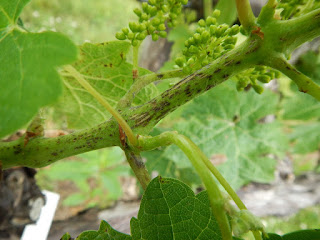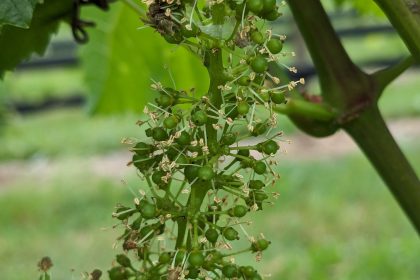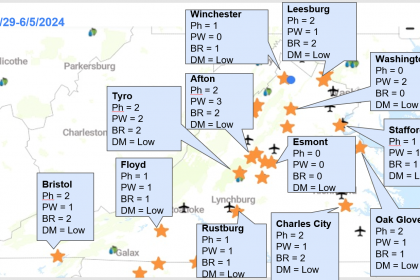One of the diseases you need to consider this time of the year is Phomopsis cane and leaf spot. It causes minor leaf spots, which is more obvious to our eyes, but the more important damage is caused by necrotic lesions on shoots and rachis. It also causes berry rot; however, it is not common with wine grapes because of our spray programs. Materials for black rot and downy mildew are often effective against Phomopsis. Thus, the fungicide coverage for these diseases is also working as management of Phomopsis, especially later in the spring and early summer. Some cultivars, such as Viognier and Seyval Blanc, are more susceptible to Phomopsis than the others.
Phomopsis takes a while to establish in the vineyard. It may take 5-6 years for Phomopsis to become noticeable if you start a new vineyard. However, once established in a vineyard, it is difficult to get rid of this disease. Phomopsis tends to become noticeable as a vineyard gets older because of its life cycle. The fungus survives in canes and trunks that were infected in previous years. During the spring, it will produce spores on the surface of infected tissues, and these spores are splashed by rain onto new shoots or leaves. Luckily, the pathogen (Phomopsis viticola) produces spores mainly during the springtime. Thus, unlike the other diseases we face, there is only one major infection period throughout the season. Because of that, the spread of Phomopsis does not happen rapidly as other grapevine fungal diseases, such as downy mildew. Moreover, Phomopsis spores can cause infection under the relatively cooler environment (the upper 40s). Thus, springtime rain events are ideal for Phomopsis to produce spores and cause infection. Unfortunately, we do not have curative fungicides for Phomopsis management; therefore, it is important to protect young tissues when they come out from the older canes and trunks.
If rain events are coming into the picture after bud break, mancozeb (FRAC=M3, Penncozeb, Dithane, Manzate, etc.), Ziram (FRAC = M3), and captan (FRAC = M4) are effective protective materials against Phomopsis. In a typical year, one or two applications from 1-2 inch shoot growth will be sufficient, because your downy mildew or black rot applications, which happens in the late spring, will cover Phomopsis as I mentioned earlier. QoI, such as Abound and Pristine, as well as SDHI, such as Luna Experience and Aprovia, work too; however, you don’t want to use them this early in the season because you will need these materials for the latter part of the season to control other diseases. Once again, protection is the only mean of chemical management because no materials are effective after the infection.






